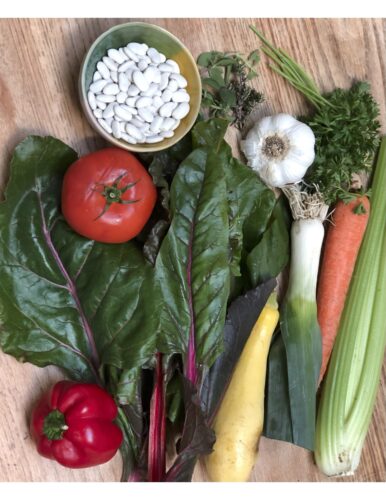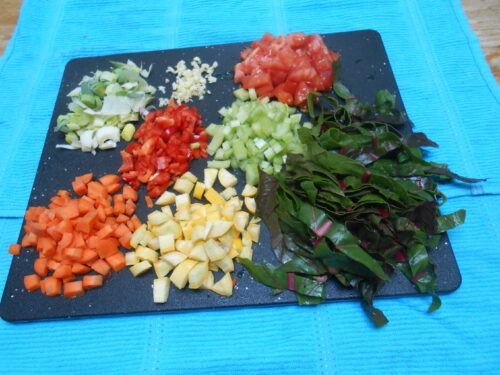New Year’s Resolution: EAT MORE VEGETABLES! With a Warming Recipe For the New Year

By Shanta Nimbark Sacharoff
Many New Year’s resolutions revolve around modifying behaviors, especially changing eating habits. During the holidays, we are surrounded by unhealthy foods, bombarded with their ads and end up indulging. Once the holidays are behind us, many people resolve to cut down on sweets and other empty calories. But how about a positive spin on changing food habits by addition something good in our diet–such as eating more fresh vegetables and fruits? And if you already consume a lot of fresh produce, share some with friends and family members. Sharing is caring!
You might say what is the need? Don’t we eat enough vegetables and fruits? And why it is so important to eat a lot of vegetables and fruits?
Here are the answers: the latest national nutritional surveys show that over 80% of Americans do not eat enough fruits and 90% of us do not eat enough vegetables. We are eating less vegetables and fruits now than ever before. This is why the government’s guidelines as outlined in “Choose my Plate” recommend that half of our daily food consumption consist of vegetables, fruits, and whole grains. They no longer emphasize the now outdated Nutrition Pyramid where the meat group or its protein alternatives were on top (“meat” is not listed as a group in my plate). You can view these recommendations at https://www.myplate.gov/.

Protein, which literally means “of importance,”, builds and maintains our body’s tissues. However, nutritional surveys indicate that most Americans consume more protein than their bodies require which can convert into fat. Furthermore, the surveys show that it is the micronutrition requirements that many Americans are not meeting. Your body needs the micronutrients such as vitamins and minerals from your daily diet in addition to protein and carbohydrates to maintain bodily functions. Specifically, micronutrients help us with digestion and prevention of chronic illnesses. Foods that are rich in micronutrients are vegetables and fruits. This is why we need to eat a lot of fresh vegetables and fruits.
Vegetarians generally consume more vegetables than their omnivore counterparts, but I know vegetarians who do not eat vegetables! Not nearly enough! Some of them load up their plates with carbohydrates and cheese. A nutritionally balanced menu should include fresh fruits and vegetables, whole grains and some protein-rich foods. And, don’t forget, vegetables contain protein too!
In California, we are blessed with fresh vegetables and fruits year around. So why do some Californians not eat enough vegetables? Here are a few reasons: First of all, even in California, there are places that do not have markets that carry fresh produce. And many of us eat our meals out-of-home where fresh vegetables and fruits may not be included. Our kids grow up eating their meals in school cafeteria where fresh vegetables may not be served. Plus, there is the deep-rooted prejudice some of us have built against vegetables that were poorly cooked and force-fed to us in our childhood. So, let us break the prejudgment and resolve to make some changes. How do we do that? Here are some practical tips and suggestions along with a warming recipe that will help you to include more fresh vegetables and fruits in your diet and/or help others to do that.
A few basic tips that can help you to plan a vegetable and fruit- centered diet:
- Start your weekend (or a day off) by shopping for fresh produce at a nearby market, at a supermarket or from a farmer’s market. I start my Sunday by shopping at the Outer Sunset Farmers market for fresh produce and add other food items, more fruits and vegetables from my favorite shop, Other Avenues Food Co-op on Judah and 44th avenue.
- Reduce meat and other costly items to budget for more fresh produce. Always include some leafy greens–some of them being raw to be eaten as salads. In addition to adding valuable micronutrients, raw greens provide fibers which are helpful in our digestion.
- Use fresh fruits as a snack and serve them as a dessert.
- Plan a few meals for the week and make a shopping list for vegetables and fruits. Select some simple dishes, such as a quick soups, salads and small plates for the working days.
- When planning menus, try to complement elements such as texture, consistency, and temperature of the dishes. For example, a pasta entrée goes well with a saucy soup and a substantial slice of a vegetable quiche pairs well with a light salad. Cold nights might start with a hot bowl of brothy soup, followed by a small plate or a casserole and a salad.
- Be creative! Combine your favorite easy dishes with something new you have just learned how to make. Combine various ethnic components to create a refreshing menu. For example, you might serve a rice/quinoa pilaf with a ratatouille.
- A few kitchen gadgets such as two good knives and a food processor (and/or blender) are very helpful for preparing vegetable dishes.
- Work ahead of time when you can. Some preparation can be done ahead of time to better manage the day of serving. For example, a salad dressing can be made for the week in advance. Other tasks, such as chopping vegetables for a soup can happen hours ahead.
- It has been said that we eat with our eyes. Take time to arrange fresh colorful ingredients to please the eyes. You will simultaneously tempt your taste buds and increase your level of satisfaction with the food you eat.
- For an elaborate dish such as a lasagna for the weekend, involve other family members or roommates. Each step (such as grating cheese and making the sauce) can be done ahead of time, by different persons. Kids can cook too. Get them involved in the kitchen at early age. Cooking together and sharing the meal with your loved ones is always joyful!
Vegetable Soup with White Kidney Beans and Red Chard
This hearty soup can be made with a variety of vegetables and leafy greens. The consistency can vary from being a substantial stew-like one pot meal or a hydrating entré with a lot of broth. Either way, it is delicious. For a thick soup, start with a little less water and add some cubed potatoes. For a more brothy soup, start with more water. Fresh herbs give this soup an elegant touch.

½ to ¾ cup dried cannellini beans, or 1½ cups canned cannellini beans
Water as needed for boiling dried beans
2 – 3 tablespoons of olive oil
1 stalk of leek, or a few stalks of scallion, chopped with some green portion, about 1 cup
2 cloves of garlic, minced
½ red bell pepper (about ½ cup) cut into very small pieces
1 carrot finely diced, approximately 1 cup of diced carrots
2 or 3 stalks of celery, finely diced, about 1 cup when diced
1 zucchini or yellow summer squash cut into cubes, about 1 cup
1 large or two medium sized chopped tomatoes OR canned tomatoes, 1½ cups
2 tablespoons fresh parsley minced
½ teaspoon each fresh thyme and oregano, minced (or ½ dried Italian herbs)
½ bunch red chard (2 cups), cut into ribbons after trimming (keep inner red veins and some stalks)
Approximately 4 to 5 cups water
1 medium potato, peeled and cubed to measure about a cup, (*optional—for a thicker soup)
1 to 1½ cup of water to crush some of the beans
Salt and freshly grated black pepper to taste
½ cup red wine or vinegar
1 teaspoon sugar or honey to balance the tartness of wine or vinegar
Finely grated Parmesan cheese for topping (optional)

If using dried beans, boil them in 4 cups of water for 45 minutes or until very soft. Cannellini beans take less time to cook than many dry beans. (You can speed up this step by first soaking them in warm water for 1 to 2 hours). Drain and set the cooked beans aside. If using canned beans, do not boil them. Drain the canned beans, discarding its liquid and set them aside.
Heat the oil in a pot and stir-fry the leek for 2 minutes. Add the garlic and bell pepper and continue to fry them for a minute. Add the carrots, celery and summer squash. Sautee the mixture for a few minutes. Next, add the tomatoes, parsley and herbs and stir-fry for five minutes until tomatoes soften. Add the chard. Then add water and bring the mixture to a boil. (Also, now add the optional potatoes for a thicker soup.) Reduce the heat. Let the soup simmer while preparing the next step.
Using an electric blender or a food processor, puree half of the beans with 1 or 1½ cup of water and leave the other half intact. Add pureed and unpureed beans to the simmering soup. Add salt and pepper to taste. Add the red wine or vinegar to the soup. Taste to adjust the seasonings. Add the optional sweetener if you need to balance the flavors. Cook the soup for 10 minutes, until the vegetables and beans are soft and integrated. Pass a bowl of grated cheese (optional) for topping. Serve with croutons or bread rolls or pasta.
Makes six to eight servings
____________________________________________________________________________
Recipe adopted from “Cooking Together: a Vegetarian Co-op Cookbook” ©2017 Shanta Nimbark Sacharoff.
Shanta is a Sunset District resident and the author of “Cooking Together” and “Flavors of India,” both available at Other Avenues Food Co-op, Green Apple Book Store, Rainbow Grocery Co-op, and at other local bookstores. Shanta writes recipes and articles on food and teaches cooking classes. She shares recipes on her YouTube channel.










